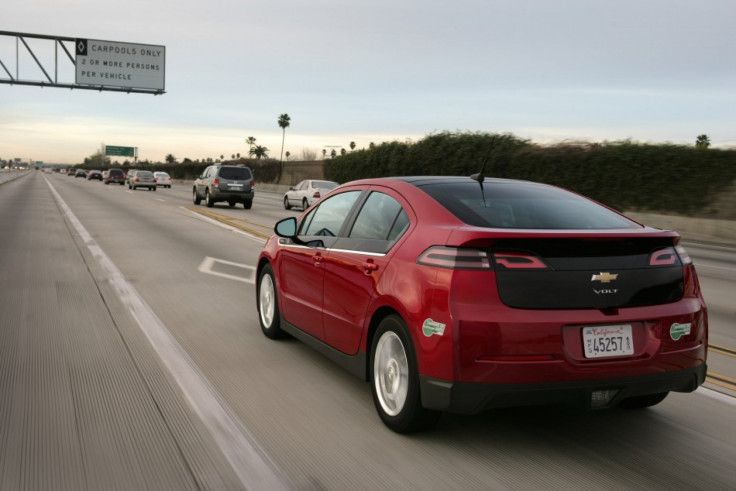HOV-Lane Access Drives Electric Car Sales In California

Sales of the Chevrolet Volt Hybrid-Electric Vehicle (HEV) have experienced a surge in California following tweaks that now allow the car from General Motors Company (NYSE: GM) to qualify for High Occupancy Vehicle (HOV) lane access, even if only one person is the car.
Moreover, HOV lane access has become a primary driver for sales of HEV and EV cars in California as consumers turn to the eco-friendly cars not to save the planet but to shave some minutes of their commutes. California accounts for as much as 50 percent of EV sales each month, according to Alec Gutierrez, senior market analyst for automotive insights at Kelley Blue Book.
In California, EVs and HEVs that meet certain emissions standards can get a sticker allowing them into in HOV lanes even when there are no passengers besides the driver. Consequently, owners of electric cars that meet the requirement can zip by rush hour traffic that they might otherwise be stuck in. Electric car drivers' right to use HOV lanes in California is a pretty significant contributor to EV sales in the state, according to Gutierrez.
General Motors initially launched the Volt without meeting California's requirements for HOV lane access because it felt it would take too long, according to Mike Omotoso, senior manager for global powertrain at LMC Automotive. Since then, GM has made changes to the Volt to allow it to qualify.
In late 2011, before the changes to the Volt went into effect that allow it to be driven in the HOV lane with only one occupant, California accounted for just 10 percent of Volt sales. In March, after the change, 27.7 percent of Volts were sold in California, a resurgence I would attribute at least partially to the availability of HOV stickers for the cars, Gutierrez said.
The major volume EVs on the U.S. market for which there is sales data are the Nissan Leaf, Toyota Prius Plug-in and the Chevy Volt. All three qualify for California's HOV lane. In March, 80 percent of Prius Plug-in sales were in California.
Under previous regulations that ended with the 2009/10 model year, standard hybrids like the Prius could access HOV lanes in California. Under those regulations, the standard Prius hybrid retained significant used resale value over other competitors if the particular car had an HOV sticker on it, according to Gutierrez.
HOV lane access has proved to be a boon for all EVs, and Nissan and General Motors are both actively advertising it as a benefit of driving one of their electric cars.
In California, it's a nice, high benefit of the car. I think the state has figured out that it's a good way to build interest in EVs and it works, Nissan USA spokesman Tim Gallagher said of the Nissan Leaf.
Other states like Arizona and Virginia also offer HOV lane access for EVs, but they represent a much smaller percentage of market share for those cars.
While the Nissan Leaf, Toyota Prius Plug-in and Chevy Volt are all subject to a $2,500 tax credit from the state of California, that credit has little effect on boosting sales of the vehicle. The federal tax credit is $7,500. However, even once the state and federal tax credits for EVs are taken in account, EVs still come at a great premium in terms of cost over compact cars that can get as much as 40 mpg, even with fuel savings taken into account, according to Gutierrez. With the Volt running a $39,145 MSRP, that leaves HOV access as a primary motivation for buying an EV in California.
Nine out of 10 Volt buyers were primarily motivated by HOV access, according to one dealer interviewed by the Detroit Free Press. However, General Motors idled Volt production briefly earlier in the year, and dealers throughout California are reporting shortages now that the cars have access to HOV lanes.
General Motors Company (NYSE: GM) shares rose 1.14 percent to $22.17 Tuesday.
© Copyright IBTimes 2024. All rights reserved.




















